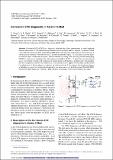Correlation ECE diagnostic in Alcator C-Mod
Author(s)
Sung, Choongki; White, Anne E.; Howard, Nathaniel Thomas; Mikkelsen, David; Irby, James Henderson; Leccacorvi, Rick; Oi, Curran; Rice, John E.; Reinke, Matthew Logan; Gao, Chi; Ennever, Paul Chappell; Porkolab, Miklos; Churchill, Randy; Theiler, Christian; Greenwald, Martin J.; Walk Jr, John R; Hughes Jr, Jerry; Hubbard, Amanda E; Vieira, Rui F; ... Show more Show less
DownloadPorkolab_Correlation ECE.pdf (1.657Mb)
PUBLISHER_CC
Publisher with Creative Commons License
Creative Commons Attribution
Terms of use
Metadata
Show full item recordAbstract
Correlation ECE (CECE) is a diagnostic technique that allows measurement of small amplitude electron temperature, T[subscript e], fluctuations through standard cross-correlation analysis methods. In Alcator C-Mod, a new CECE diagnostic has been installed[Sung RSI 2012], and interesting phenomena have been observed in various plasma conditions. We find that local T[subscript e] fluctuations near the edge (ρ ~ 0:8) decrease across the linearto- saturated ohmic confinement transition, with fluctuations decreasing with increasing plasma density[Sung NF 2013], which occurs simultaneously with rotation reversals[Rice NF 2011]. T[subscript e] fluctuations are also reduced across core rotation reversals with an increase of plasma density in RF heated L-mode plasmas, which implies that the same physics related to the reduction of T[subscript e] fluctuations may be applied to both ohmic and RF heated L-mode plasmas. In I-mode plasmas, we observe the reduction of core T[subscript e] fluctuations, which indicates changes of turbulence occur not only in the pedestal region but also in the core across the L/I transition[White NF 2014]. The present CECE diagnostic system in C-Mod and these experimental results are described in this paper.
Date issued
2015-03Department
Massachusetts Institute of Technology. Department of Nuclear Science and Engineering; Massachusetts Institute of Technology. Department of Physics; Massachusetts Institute of Technology. Plasma Science and Fusion CenterJournal
EPJ Web of Conferences
Publisher
EDP Sciences
Citation
Sung, C., A. E. White, N. T. Howard, D. Mikkelsen, J. Irby, R. Leccacorvi, R. Vieira, et al. “Correlation ECE Diagnostic in Alcator C-Mod.” Edited by S. Kubo. EPJ Web of Conferences 87 (2015): 03007.
Version: Final published version
ISSN
2100-014X